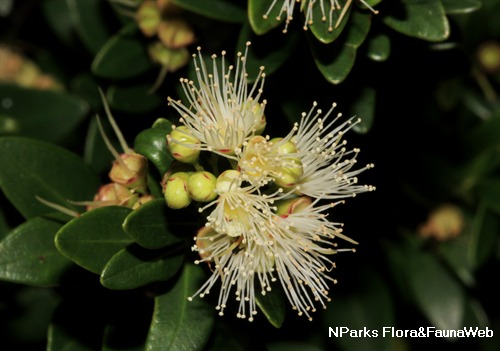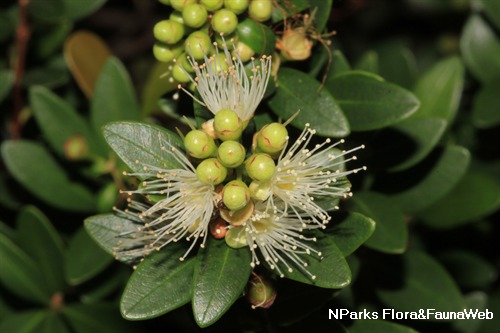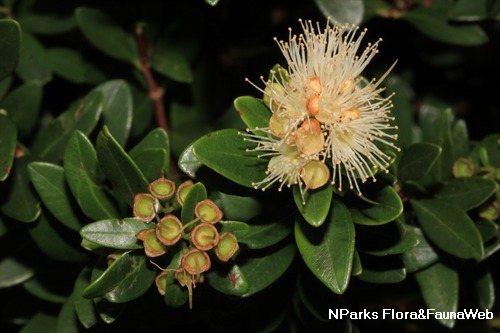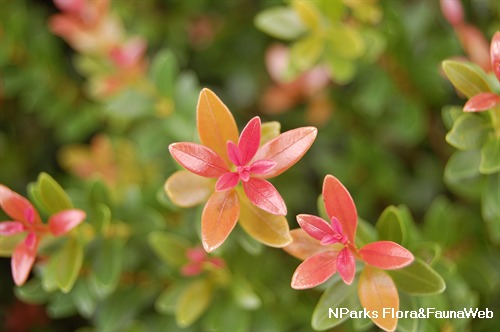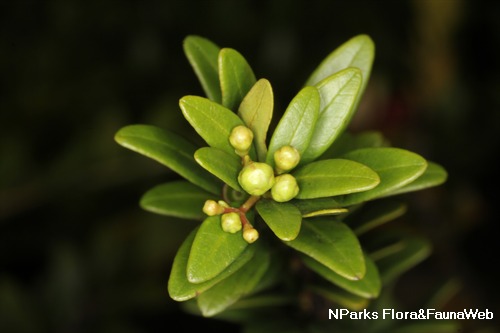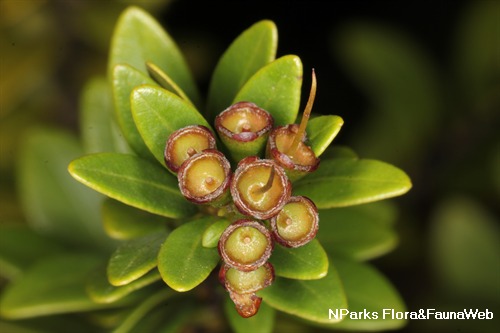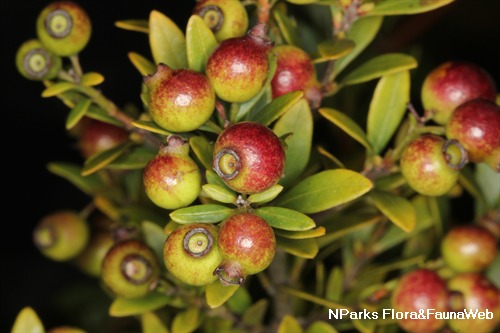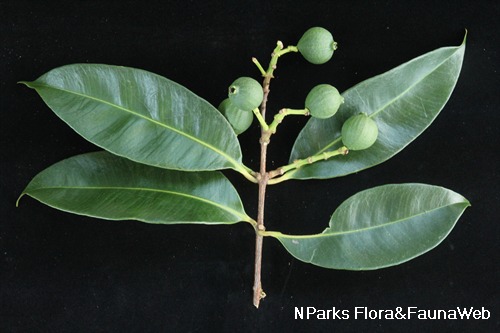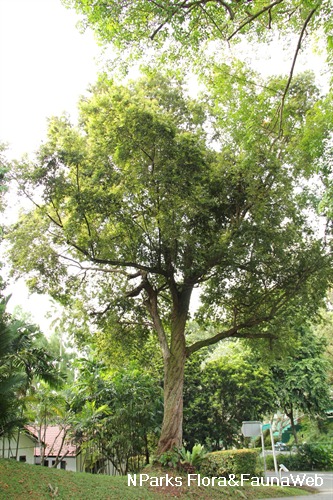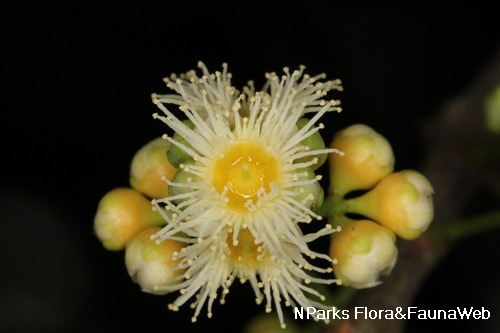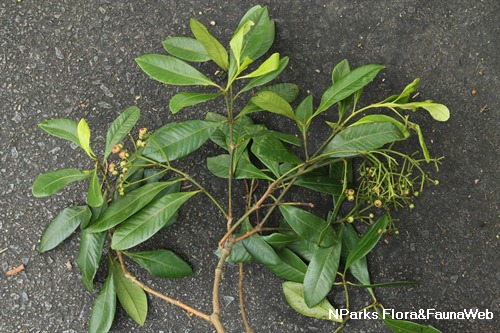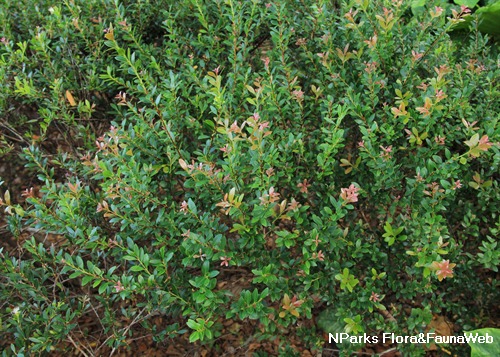
Back
Syzygium buxifolium Hooker & Arnott
| Family Name: | Myrtaceae |
| Synonyms: | Eugenia microphylla, Syzygium microphyllum, Eugenia sinensis |
| Common Name: | Box-leaved Eugenia, Fish-scale Bush, 赤楠, 小叶赤楠, 鱼鳞木 |
Name
Classifications and Characteristics
| Plant Division | Angiosperms (Flowering Seed Plants) (Dicotyledon) |
|---|---|
| Plant Growth Form | Shrub, Tree (Shrubby (1m-5m)) |
| Lifespan (in Singapore) | Perennial |
| Mode of Nutrition | Autotrophic |
| Plant Shape | Compact |
| Maximum Height | 4.5 m |
| Maximum Plant Spread / Crown Width | 3 m to 4.5 m |
Biogeography
| Native Distribution | China, Taiwan, Southern Japan, Vietnam |
|---|---|
| Native Habitat | Terrestrial (Temperate Forest, Grassland / Savannah/ Scrubland) |
| Preferred Climate Zone | Sub-Tropical / Monsoonal, Temperate |
| Local Conservation Status | Non-native |
Description and Ethnobotany
| Growth Form | Woody shrub or small tree, up to 4.5 m height. Compact and densely-branched. |
|---|---|
| Foliage | Leaves small, narrow, blunt tipped, veins inconspicuous, dark green; young leaves reddish. |
| Stems | Reddish-brown, slightly 4 or 6-angled when young. |
| Flowers | Powderpuff, in terminal few-flowered cymes, 4 inconspicuous small white petals which fall off as flower opens, numerous white filaments with yellow anthers. |
| Fruit | Globuse berries, ripen from green to red to shiny purplish-black, 7 - 10mm across, with fleshy pulp and single large seed. |
| Cultivation | Prefers open, well-drained but moisture-retaining soils. Takes pruning well. |
| Etymology | Genus epithet 'Syzygium' derived from 'syzygos' (Greek for 'joined'), alluding to the opposite paired leaves. Species epithet 'buxifolium' means "box-leaved", describing the fine-textured foliage which resembles that of Buxus species (Box). |
| Ethnobotanical Uses | Edible Plant Parts : Edible Fruits Food (Herb or Spice) Others: Juicy ripe fruits are edible, and also used to make wine. Roots used to treat asthma, scalds and injuries, and strengthen spleen. |
Landscaping Features
| Desirable Plant Features | Ornamental Flowers, Ornamental Foliage |
|---|---|
| Landscape Uses | Container Planting, Suitable for Bonsai, Flowerbed / Border, Hedge / Screening, Parks & Gardens |
| Thematic Landscaping | Naturalistic Garden, Formal Garden |
| Plant & Rootzone Preference or Tolerance Remarks | Prefers open, well-drained but moisture-retaining soils |
Plant Care and Propagation
| Light Preference | Semi-Shade, Full Sun |
|---|---|
| Water Preference | Moderate Water |
| Plant Growth Rate | Moderate |
| Rootzone Tolerance | Well-Drained Soils, Moist Soils |
| Maintenance Requirements | Moderate |
| Pruning | Takes pruning well. May be pruned frequently. |
| Propagation Method | Seed, Stem Cutting |
Foliar
| Foliage Retention | Evergreen |
|---|---|
| Mature Foliage Colour(s) | Green, Red |
| Mature Foliage Texture(s) | Smooth, Thin |
| Prominent Young Flush Colour(s) | Red |
| Foliar Type | Simple / Unifoliate |
| Foliar Arrangement Along Stem | Opposite |
| Foliar Attachment to Stem | Petiolate |
| Foliar Shape(s) | Non-Palm Foliage (Obovate, Elliptical) |
| Foliar Venation | Pinnate / Net |
| Foliar Margin | Entire |
| Typical Foliar Area | Notophyll ( 20.25cm2 - 45 cm2 ) |
| Leaf Area Index (LAI) for Green Plot Ratio | 4.5 (Shrub & Groundcover - Dicot) |
Non - Foliar and Storage
| Trunk Type (Non Palm) | Woody |
|---|---|
| Bark Colour(s) | Reddish bark on young stems |
| Stem Type & Modification | Woody |
| Root Type | Underground (Tap Root, Fibrous Root) |
Floral (Angiosperm)
| Flower & Plant Sexuality | Bisexual Flowers |
| Flower Colour(s) | White |
|---|---|
| Flower Grouping | Cluster / Inflorescence |
| Flower Symmetry | Radial |
| Flower Size - Remarks | Small, 1cm across |
| Inflorescence Type | Cyme |
| Flowering Period | Free-Flowering |
| Flowering Opening Time | Time-Independent |
| Flowering Habit | Polycarpic |
Fruit, Seed and Spore
| Mature Fruit Colour(s) | Black, Purple |
|---|---|
| Fruit Classification | Simple Fruit |
| Fruit Type | Fleshy Fruit , Berry |
Image Repository
Others
| Master ID | 962 |
|---|---|
| Species ID | 2256 |
| Flora Disclaimer | The information in this website has been compiled from reliable sources, such as reference works on medicinal plants. It is not a substitute for medical advice or treatment and NParks does not purport to provide any medical advice. Readers should always consult his/her physician before using or consuming a plant for medicinal purposes. |

